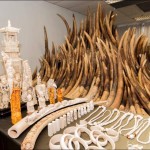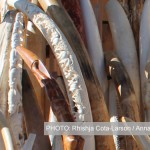
The Hong Kong government has announced it has decided to incinerate 28 tonnes of its 33-tonne confiscated ivory stockpile in installments over a one-to-two year period, starting in the first quarter of 2014.
A representative stated that one tonne will remain in the custody of the Hong Kong Agriculture, Fisheries and Conservation Department (AFCD) for uses permitted under CITES. The government also pledged that all future ivory seizures will also be incinerated along with the existing stockpile, and that publicity events to promote conservation of elephants and other endangered species will be organized in connection with the ivory disposal plan.
The decision was made at a meeting which was held today between Hong Kong’s AFCD and an Endangered Species Advisory Committee (ESAC) made up of 15 representatives. The meeting followed a concerted effort from local activists, who campaigned in favour of the burning of the stockpile (see previous story: “Activists Lobby Hong Kong Government to Burn Ivory Stockpile“).

When asked why the the government is taking so long to destroy the stockpile, the government representative replied that it largely comes down to convenience:
“It’s going to take 1-2 years to burn the stockpile because HK will make use of the facilities operated by the environmental protection department’s (EPD’s) chemical waste treatment plant. Their normal work is to incinerate chemical waste including waste oil for energy, and we will make use of this opportunity to incinerate ivory – which requires destruction at a very high temperature. So we have to fit it in with the work schedule of the EPD, because the waste oil is not always there, so we have to wait to accumulate it. Also we need to do it batch by batch because from our trial we have established that the maximum amount of ivory that can be handled by the machinery is 3 tonnes at a time, and for each treatment we have to prepare a lot of procedures beforehand, including security and reducing the size of the ivory to a suitable length for incineration, so there are a lot of arrangements to be made.”
The decision was announced on January 23, 2014.




